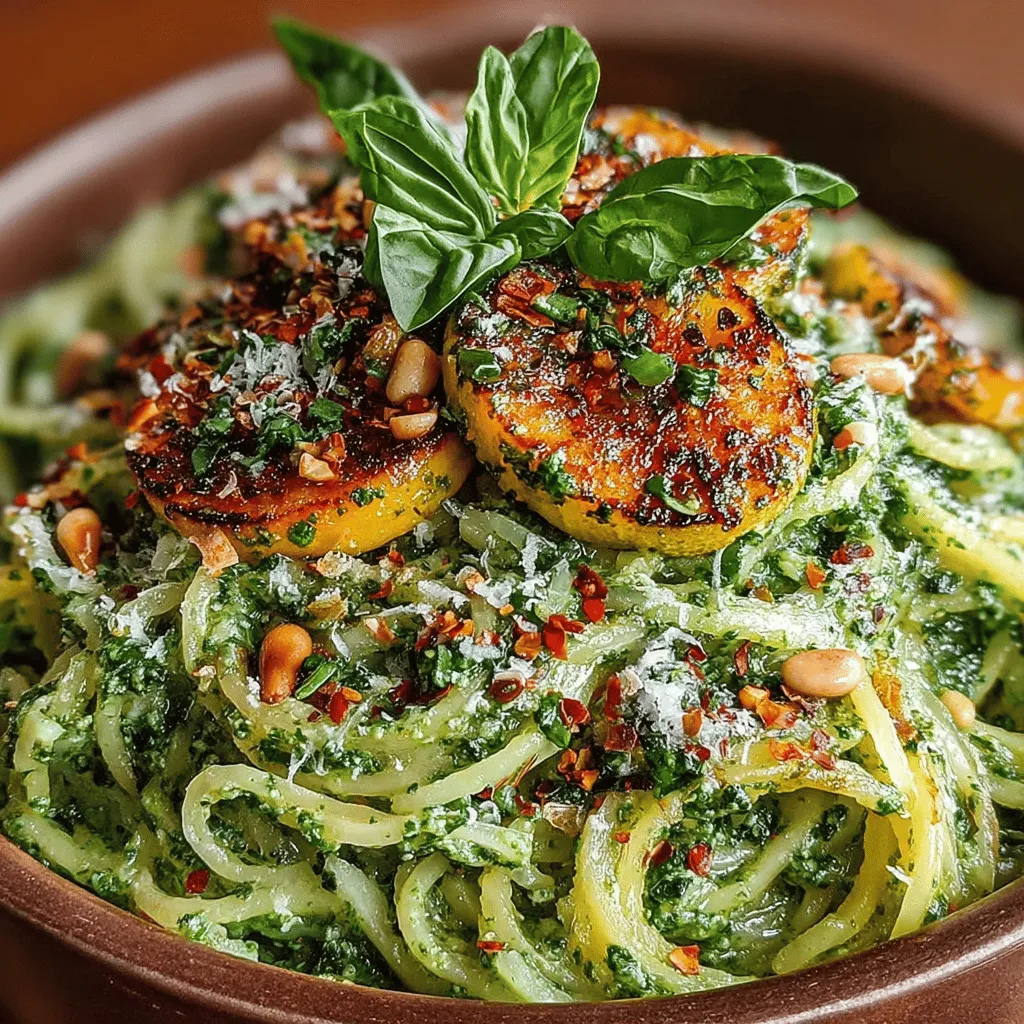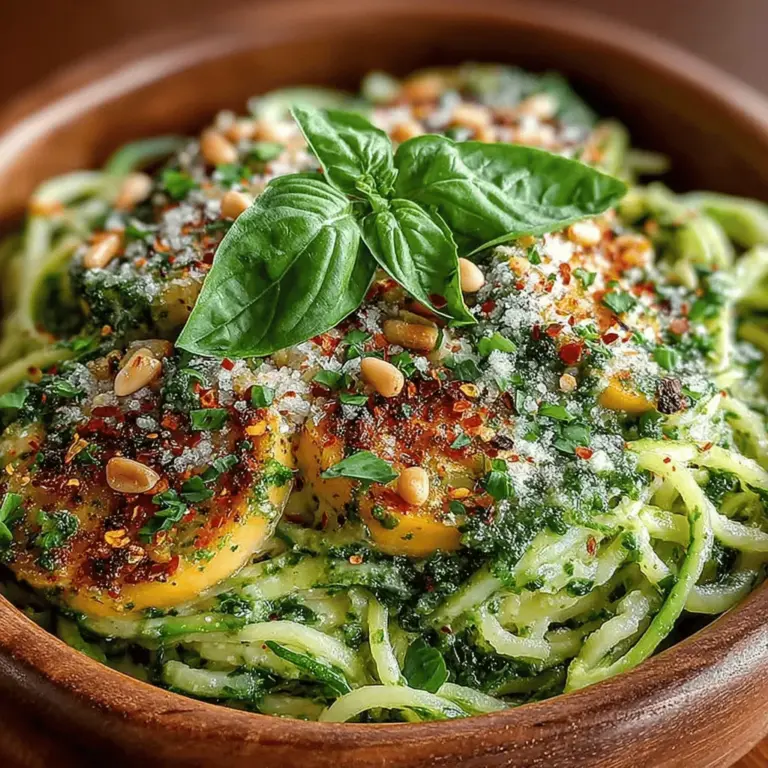Creamy Spinach Pesto Spaghetti Squash: A Deliciously Healthy Dish
In today’s health-conscious world, finding meals that are both delicious and nutritious can be a challenge. Enter Creamy Spinach Pesto Spaghetti Squash, a dish that beautifully balances flavor and wellness. This recipe not only tantalizes the taste buds but also serves as a fantastic alternative to traditional pasta dishes. The creamy spinach pesto adds a rich depth to the naturally sweet and unique texture of spaghetti squash, making it an appealing choice for anyone looking to enhance their diet without sacrificing taste.
Spaghetti squash is a true gem in the realm of healthy eating. With its low calorie count and high fiber content, it stands out as an ideal substitute for conventional pasta. This winter squash is not only low in carbohydrates but also rich in vitamins A and C, making it a powerhouse of nutrition. Paired with the nutrient-dense spinach, which is packed with iron, calcium, and antioxidants, this dish offers a wealth of health benefits. Moreover, the creamy pesto elevates the entire meal, providing a satisfying and indulgent experience without the guilt typically associated with creamy sauces.
Pesto, a traditional Italian sauce made from basil, garlic, pine nuts, olive oil, and Parmesan cheese, is renowned for its versatility. While the classic version is a crowd favorite, variations abound, with spinach being an excellent addition that enhances both flavor and nutrition. Creamy spinach basil pesto takes this beloved sauce a step further, offering a smooth, rich texture that pairs perfectly with spaghetti squash. This dish caters to various dietary preferences, including vegetarian and vegan options, making it suitable for almost any table.
Understanding Spaghetti Squash
Spaghetti squash, scientifically known as *Cucurbita pepo*, is a unique variety of winter squash known for its distinctive stringy flesh. When cooked, the flesh can be easily scraped into spaghetti-like strands, which is where it gets its name. This vegetable is not only visually appealing but also offers a delightful textural contrast to the creamy pesto, adding an element of surprise to each bite.
Nutritionally, spaghetti squash is a fantastic option for those looking to reduce their carbohydrate intake. A one-cup serving of cooked spaghetti squash contains only about 42 calories, making it an excellent choice for calorie-conscious individuals. Additionally, it is rich in dietary fiber, which aids in digestion and can help maintain a healthy weight. Compared to traditional pasta, which can be calorie-dense and high in carbohydrates, spaghetti squash provides a lighter alternative that doesn’t compromise on satisfaction.
The Versatility of Pesto
Pesto is a sauce that has won hearts around the globe, thanks to its vibrant flavor and adaptability. The traditional pesto recipe includes fresh basil, garlic, pine nuts, Parmesan cheese, and olive oil, creating a robust and aromatic sauce that complements a variety of dishes. However, pesto is not limited to just these ingredients. By incorporating spinach, a nutrient-rich leafy green, you can create a spinach basil pesto that offers a fresh twist on the classic.
Spinach basil pesto is not only delicious but also a healthier alternative. Spinach adds a mild earthiness and vibrant green color to the sauce, while also increasing its nutrient content significantly. This variation can be made creamy by incorporating ingredients like Greek yogurt or cashews, which provide a satisfying texture without the heaviness of traditional cream-based sauces. For those following a vegan or dairy-free diet, the pesto can easily be adapted by omitting the cheese or substituting it with nutritional yeast, which adds a cheesy flavor without the dairy.
Ingredients Breakdown
To create this delightful Creamy Spinach Pesto Spaghetti Squash, you’ll need a handful of fresh, high-quality ingredients. Here’s a breakdown of what you’ll need and their roles in the dish:
– Spaghetti Squash: The star of the show, providing a low-calorie, gluten-free base for the dish.
– Fresh Spinach: Adds a nutrient boost and vibrant color to the pesto.
– Fresh Basil: Infuses the pesto with its signature aromatic flavor.
– Pine Nuts: Contribute creaminess and a rich, nutty flavor to the pesto.
– Garlic: Enhances the overall flavor profile with its aromatic qualities.
– Olive Oil: Adds richness and helps to blend all the ingredients into a smooth sauce.
– Parmesan Cheese (or nutritional yeast for a vegan option): Provides depth and creaminess to the pesto.
Using fresh ingredients is crucial for achieving the best flavor and nutritional benefits in this recipe. Fresh spinach and basil will yield a more vibrant and flavorful pesto compared to their dried counterparts. Additionally, the quality of olive oil can greatly influence the overall taste, so opt for extra-virgin olive oil for the best results.
For those with dietary restrictions, substitutions are easy to make. If you’re looking for a vegan option, simply skip the cheese and use nutritional yeast instead. If nuts are a concern, sunflower seeds or pumpkin seeds can be used in place of pine nuts, maintaining the creamy texture while accommodating different dietary needs.
Preparing the Spaghetti Squash
Now that we have our ingredients ready, it’s time to prepare the spaghetti squash. Selecting a ripe, firm squash is the first step. Look for a squash that feels heavy for its size and has a uniform color without blemishes. Once you’ve chosen your spaghetti squash, follow these steps to prepare it for roasting:
1. Preheat the Oven: Start by preheating your oven to 400°F (200°C). This temperature is ideal for roasting and will help bring out the natural sweetness of the squash.
2. Cut the Squash: Using a sharp knife, carefully slice the spaghetti squash in half lengthwise. This step can be a bit tricky, so take your time to avoid accidents. If needed, you can microwave the squash for a few minutes to soften it slightly, making it easier to cut.
3. Scoop Out the Seeds: Once halved, use a spoon to remove the seeds and any stringy bits from the center of the squash. This will create a hollow space for the delicious pesto to inhabit later.
4. Season and Roast: Drizzle the cut sides of the squash with olive oil and sprinkle with salt and pepper. Place the squash halves cut-side down on a baking sheet lined with parchment paper. Roasting the squash cut-side down helps to trap the moisture and keep the flesh tender.
5. Roast Until Tender: Bake in the preheated oven for about 30 to 40 minutes, or until the flesh is fork-tender. The time may vary based on the size of your squash, so check for doneness by inserting a fork into the flesh; it should easily shred into strands.
6. Scrape the Flesh: Once roasted, remove the squash from the oven and let it cool for a few minutes. Use a fork to scrape the flesh of the squash, creating spaghetti-like strands. This is where the magic happens, transforming the squash into a delightful base for your creamy spinach pesto.
With the spaghetti squash prepared, you are now ready to move on to creating the creamy spinach basil pesto, which will complete this nutritious and satisfying dish.

Instructions for Making the Pesto
To create a rich and flavorful pesto that will elevate your spaghetti squash dish, begin by gathering your ingredients: fresh spinach, basil, garlic, nuts (such as pine nuts or walnuts), olive oil, Parmesan cheese (or nutritional yeast for a vegan option), and salt. The balance of these flavors is crucial. Spinach provides a mild earthiness, while basil contributes a fragrant herbal note. Garlic introduces a zesty kick, and nuts add a delightful crunch and depth.
1. Combine Ingredients: In a food processor, add 2 cups of fresh spinach, 1 cup of fresh basil leaves, 2 cloves of garlic, and 1/4 cup of your choice of nuts.
2. Blend: Pulse the mixture until finely chopped. Scrape down the sides of the bowl as needed to ensure everything is evenly blended.
3. Add Olive Oil: With the processor running, gradually drizzle in 1/2 cup of extra virgin olive oil until the pesto reaches your desired consistency.
4. Season and Finish: Add 1/4 cup of grated Parmesan cheese (or nutritional yeast for a vegan version) and a pinch of salt. Blend again until smooth, adjusting seasoning to taste.
Importance of Balancing Flavors
The key to a great pesto lies in the balance of its ingredients. Too much garlic can overpower, while insufficient nuts can lead to a lack of creaminess. Taste and adjust as needed – if it’s too bitter, consider adding a touch more olive oil or cheese. If it’s too garlicky, a little more spinach and basil can help mellow the flavors.
Tips on Adjusting Consistency and Seasoning
If your pesto is too thick, add a bit more olive oil or a splash of water to loosen it up. Conversely, if it’s too runny, incorporating additional nuts or cheese can help thicken it. Always taste your pesto as you go; seasoning is subjective, and your preferences will guide you to the perfect blend.
Crafting the Creamy Sauce
The creamy element of your dish can be achieved through various methods, with cream cheese and cashew cream being popular choices.
1. Using Cream Cheese: If you prefer a rich, creamy sauce, begin by softening 8 ounces of cream cheese at room temperature. In a medium saucepan over low heat, whisk the cream cheese until it’s smooth. Gradually add in your prepared pesto, mixing until fully incorporated. If the sauce is too thick, add a splash of reserved pasta water to achieve the desired consistency.
2. Vegan Option with Cashew Cream: For a dairy-free alternative, soak 1 cup of raw cashews in water for at least 4 hours. Drain and rinse the cashews, then blend them with 1/2 cup of water, 2 tablespoons of nutritional yeast, and a pinch of salt until smooth. Fold this cashew cream into your pesto, adjusting with additional water or olive oil to reach the right consistency.
Tips on Achieving the Right Sauce Consistency
Strive for a sauce that clings to the strands of spaghetti squash without being overly watery. If your sauce feels too heavy, a little more water or stock can lighten it up. Conversely, if it seems too thin, a bit more cream cheese or cashew cream will thicken it. Always keep a close eye on the texture as you combine it with the squash.
Combining the Ingredients for a Flavorful Dish
Once your spaghetti squash is roasted and your creamy pesto sauce is ready, it’s time to combine these elements for a truly flavorful dish.
1. Tossing the Ingredients: In a large mixing bowl, scrape the flesh of the roasted spaghetti squash with a fork to create noodle-like strands. Add in your creamy pesto sauce and gently toss to coat the squash evenly, ensuring every strand is enveloped in that vibrant green goodness.
2. Adjusting Flavors and Consistency: Now is the time to taste your dish. If it needs more brightness, a squeeze of fresh lemon juice can enhance the overall flavor. If you desire a nuttier taste, a sprinkle of toasted pine nuts on top can elevate the dish.
Importance of Combining Ingredients
Combining the spaghetti squash with the pesto sauce is crucial for flavor integration. The warmth of the squash helps meld the flavors together, creating a harmonious dish. Presentation also matters; twirl the strands into nests on a plate for an inviting look.
Serving Suggestions
To make your Creamy Spinach Pesto Spaghetti Squash visually appealing, consider these presentation ideas:
– Garnishes: Top your dish with freshly chopped basil leaves, a sprinkle of pine nuts, or a dash of red pepper flakes for a pop of color and flavor. These small touches not only enhance the aesthetics but also add an extra layer of taste.
– Pairing Ideas: This dish pairs well with a light side salad tossed with a lemon vinaigrette to balance the richness of the sauce. Grilled chicken or shrimp can also complement the flavors beautifully for those who desire additional protein.
Nutritional Information
This Creamy Spinach Pesto Spaghetti Squash is not only delicious but also packed with nutritional benefits:
– Nutritional Breakdown: Each serving is rich in vitamins A, C, and K from the spinach and basil. With the inclusion of nuts, this dish also provides healthy fats and protein. The use of spaghetti squash instead of traditional pasta significantly lowers carbohydrates while adding fiber, which aids digestion.
– Dietary Suitability: This recipe can easily fit into various dietary preferences. It’s gluten-free due to the use of spaghetti squash and can be made vegan by substituting cream cheese with cashew cream and using nutritional yeast instead of Parmesan.
Conclusion
In summary, Creamy Spinach Pesto Spaghetti Squash is not only a delicious dish but also a healthy and versatile option for any meal. With its vibrant flavors and wholesome ingredients, it’s a wonderful way to enjoy a satisfying meal that caters to various dietary needs. We encourage you to try making this dish at home; you’ll find joy in the process and delight in the results. Cooking with fresh, wholesome ingredients brings a unique satisfaction that nurtures both body and soul. Enjoy every bite of your culinary creation!

